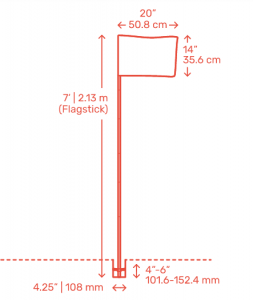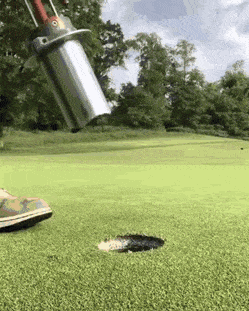The golf course consists of a series of holes in which players should get their golf ball into the hole in as few shots as possible. You will typically find golf courses with 18 holes as that is the amount of holes it takes for a standard round of golf. The hole, also known as a cup features a flagstick which marks the location of the hole.
It’s important that the golf hole is large enough so that the ball can go in, but not too big where it becomes too easy for the ball to sink. As a result, the major governing bodies (United States Golf Assoiciation and R&A) agreed upon a standard size of the golf hole for all courses to adapt.
In short, the standard size of a golf hole should measure 4.25 inches in diameter. This provides enough room for the golf ball to sink as the diameter of the ball is 1.68 inches. The depth of the golf hole should be 4 to 6 inches deep so that the golf ball doesn’t roll out of the cup.
The flag stick that is inserted into the hole will typically have a diameter of 0.75 inches and a height of 7 inches long.

Table of Contents
How They Cut And Fill Golf Holes? *Changing Locations*
The main equipment that is used to cut a golf hole is called a golf hole cutter. It is cylindrical in shape and that allows a round hole to be cut in the ground as it cleanly removes a cylinder of ground in one pull. In golf cutting, the cylinder of ground can be referred to as a plug or turf.
As you might have guessed, the diameter of the golf hole cutter is 4.25 inches with a length of 4 to 6 inches. This ensures that the golf hole size is within the regulation set by the governing bodies.
The hole on a putting green is moved generally on a daily basis depending on the course and the time of year. This helps to keep the turf healthy by spreading the wear of foot traffic over different areas on the green. It also provides the golfers with variety each time they play.
The process of changing the hole is straight forward. An area is selected that provides a 2 to 3 foot radius around the new hole that is as nearly level as possible of uniformed grade and avoids old hole plugs and ball marks that are not completely yield.
Once a location is selected, the maintenance worker uses a hole cutter to create the new hole. The worker will cut the whole as nearly on the vertical as possible. The holecutter tool removes the plug and stores it within the sleeve of the device.
The cup is removed from the present hole location and is inserted into the new hole. A setting tool is used to ensure the cup is inserted to the proper depth. This tool also ensures that turf around the hole is pressed flat and even with the surrounding turf.
The hole cutter is then inserted into the old hole. A lever is raised to eject the plug into the hole. If needed, the plug is adjusted to ensure it is perfectly level with the surrounding area. Often a knife or pick is used to nip the turf from the plug into the surrounding area which is then watered, making it nearly invisible.

Finally, debris is brushed away from both the old and new hole locations. The flagstick is inserted to complete the task. Golfers can help keep the hole’s edges neat and round. Avoid using your putter when removing the golf ball.
Use your hand to remove the golf ball and take care to avoid hitting the edges when removing and replacing the flagstick.
Why Is The Golf Hole Size 4.25 Inches? Brief History
Between the 1700s and 1800s, there was no sandardized size of the golf hole as the size of the golf hole varied from links to links. That was until the year 1829 when the first step in standardizing the hole size happened at Musselburgh Scotland on Levanhall Links.
They had made the first hole cutter that would cut holes the same size everytime. This ancient hole cutter is kept on display even today in the clubhouse at Royal Musselburgh which is an 18-hole course in Prestonpans, Scotland.
The size of this ancient hole cutter was 4.25 inches, the same size used today. However, it took some time for other golf courses around the world to catch on to this standard hole size as some were using six-inch holes.
It was not until 1891 that the 4.25 inch hole size became standardized everywhere due to the new rules issued by the Royal & Ancient Golf Club of St. Andrews. The people at the R&A apparently liked the size of the golf hole and therefore adapted it into their rules which remained in effect up until today.
Nevertheless, there have been some cries to enlargen the hole, but this is mostly for recreational golfers. Gene Sarazen who you may have known as one of the world’s top golf players in the 1920’s endorsed the idea of cutting 8-inch holes. Even modern golfers like Jack Nicklaus has cut 8 inch holes at his Muirfield Village Golf Club whenever there is a special event. Changing the golf hole size for high level golf may be inconceivable, but it’s defintetely a possibility when it comes to recreational golf as customers will enjoy the game more when they make more putts with the larger holes.
Spray Painting The Golf Hole
One of the final steps in preparing a new golf hole is to spray paint it usually with white paint. This is used so that the cup or hole is made visible to the golfer when they are taking their shots, and also for the spectators to see.
So what type of white paint is used? Well the PGA use hole in one white paint which you can get here off their store
It is easily applied and requires minimal prep time. You simply place the can upside down into the device and push down while you twist the can to paint the edge of the cup.
To ensure even coverage, you can spin it a couple times or in a different direction. The paint won’t interfere with your putting surface, balls or golf clubs. You can watch this short video to see how it works.



